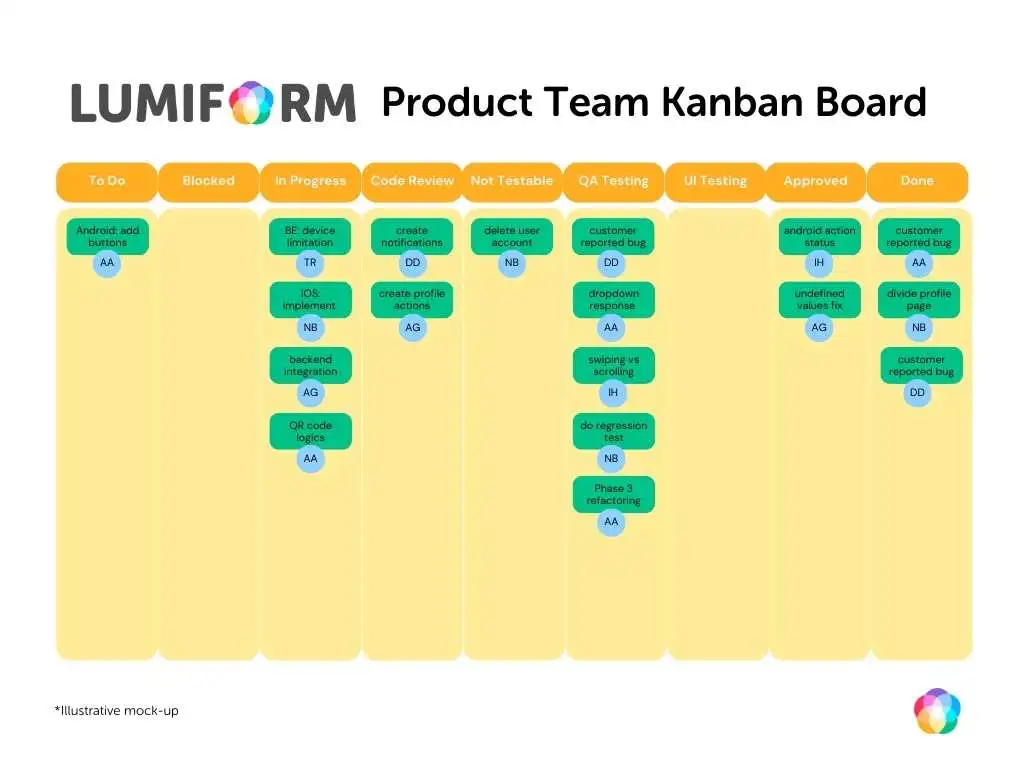Kanban, Scrum, agile methodologies; if you've ever wanted to learn more about this topic, we have a treat for you. As the first one in a series of interviews within our SaaS team, we have interviewed Ahmed, Lumiforms Scrum Master, who will answer some of the most common questions people ask about Agile software development.
Together with Ahmed, we will delve into the core principles of Scrum master duties, understand the advantages of digital tools, and uncover the reasons behind utilizing methodologies like Scrum and Kanban.
Additionally, we'll learn how team performance is measured and how agile methodologies can promote collaboration across different departments. Join us as we delve into the world of Scrum and glean wisdom from an experienced Scrum Master.
Content
1. What are the primary responsibilities of a Scrum Master?
3. Being a Scrum Master in a remote team
5. How is your Kanban board set-up?
6. Who establishes the rules in the Scrum guidelines?
7. How do you handle the strictness of Scrum when unexpected projects arise?
8. How do you measure the team's performance and track processes?
9. Can agile methodologies be applied to collaboration with other teams?

What are the primary responsibilities of a Scrum Master in agile work?
A Scrum Master has many roles and responsibilities that revolve around ensuring the successful implementation of Scrum methodologies within the team. This includes facilitating and guiding the team through the various Scrum ceremonies and processes, removing any obstacles that hinder their progress, and promoting a collaborative and agile work environment.
Could you explain what Scrum is?
Scrum is an agile methodology adopted by teams to enhance their work speed, efficiency, and overall structure. It provides a framework for planning and delivering work effectively. While there are other methodologies like Kanban, Scrum remains popular due to its focus on agility and adaptability.
The ultimate goal of Scrum, as well as other agile methodologies, is to promote collaboration and enable teams to work as efficiently as possible.
As a Scrum Master in a remote team, you primarily work digitally. Would you still prefer a digital approach if the team were co-located?
Absolutely. Even if the team were physically co-located, a digital approach offers significant advantages. It simplifies work management and eliminates the need for physical boards and manual processes. In the past, maintaining physical boards required substantial effort, such as erasing and rewriting information. Furthermore, digital tools enable better collaboration and documentation, making it easier to track progress and communicate effectively.
Which methodologies does your Lumiform developer team utilize, and what factors influenced your choice?
Our Lumiform developer team predominantly uses Scrum and Kanban methodologies. The reason behind this combination is to leverage the strengths of each. Scrum provides a structured approach that is particularly useful when onboarding junior developers. It ensures that everyone understands the process and follows it consistently.
Despite having senior developers, Scrum remains the most suitable choice for our remote team. On the other hand, Kanban offers flexibility and a task-driven approach, which is beneficial for team members who work independently.
The ultimate goal of Scrum, as well as other agile methodologies, is to promote collaboration and enable teams to work as efficiently as possible.
How is your Kanban board set up?
Our Kanban board is structured with several columns that depict various stages of work in our development process. It starts with the classic To Do column, where tasks are listed at the beginning. As work progresses, they move to the In Progress column, indicating active engagement. Once a task is completed, it is moved to the Done column. We also have specialized columns like Blocked to signify any impediments hindering progress and Not Testable to indicate task dependencies.
This setup offers a visual representation of our workflow and development process, allowing me as the Scrum Master to fulfil my duties and assess the task's progress and identify areas for improvement or potential bottlenecks.
It's important to note that our Kanban board setup is tailored to our team's specific needs and preferences. While there are some standard practices and basic principles to follow in Kanban, we have customized our board to align with our workflow and make it as transparent as possible for everyone involved.

Who establishes the rules in the Scrum guidelines? Is it the Scrum Master's duty?
Scrum is a very well known methodology, so the rules already exist. As a Scrum Master I only make sure the rules are followed, I don’t set them myself. I coach my team and make sure everyone follows the process.
In Scrum everything is pre-planned in certain ceremonies. The actual work happens in so-called sprints. A sprint is a specific period of time in which the team sets a certain amount of tasks to be completed. Our sprints, for example, are two weeks long and we plan what we will do in these meetings in our sprint plans that every team member joins.
By the end of the sprint we will then do a so-called sprint review and see whether we accomplished everything and if not we start raising questions.
This is where we go into the sprint retrospective. We evaluate our performance and see what can be improved. From my perspective this is one of the most important meetings in the entire process. And it is so valuable that other methodologies have also started to incorporate retrospectives.
For Kanban it is completely different.You just give a person a task and as soon as they finish, you can give them the other task and so on.
How do you handle the strictness of Scrum when unexpected projects arise?
While Scrum has its strict rules, we understand that unexpected projects or urgent tasks may arise during a sprint. In such cases, we adopt a flexible approach called Scrumban. Scrumban combines the best elements of Scrum and Kanban, allowing us to adapt to changes while still maintaining some planning aspects. At Lumiform, our product team utilizes Scrumban to accommodate the dynamic nature of our SaaS startup.
Here at Lumiform, our product team uses Scrumban because as a SaaS Startup we need to adapt to changes. And Scrum often doesn’t allow us that flexibility.
In short, Scrum is preferred for planning, while Kanban is more task driven and prioritizes speed. However, Kanban often focuses on high priority tasks which then means that some of the low priority tasks don’t get taken care of. In Scrum we plan and see our capacity and then we establish that we can fit some of the low priority tasks into our workflow. Determining the capacity is a trial and error process based on experience.
Kanban allows for more independent work while Scrum encourages helping others in completing tasks.
How do you measure the team's performance and track processes?
Measurement of team performance differs between Scrum and Kanban. In Scrum, we focus on planning, strategy, and predictability. We evaluate our capacity and velocity, comparing planned work with actual delivery. On the other hand, Kanban emphasizes cycle time—the duration it takes for a ticket to move from the "In Progress" to the "Done" column. By combining metrics from both methodologies, we gain a comprehensive view of our team's performance.
Can agile methodologies be applied to collaboration with other teams, such as Sales, Customer Success, or Marketing?
Agile methodologies are highly adaptable and can foster collaboration across various teams within a company. While each team may follow different workflows, the underlying principles of agility and collaboration remain crucial. At Lumiform, teams maintain their own boards and may use different software tools, but the ultimate objective is always to interact and collaborate effectively to build a successful product.
In summary, as a Scrum Master, my role involves guiding the team through Scrum processes, facilitating collaboration, and ensuring the successful implementation of agile methodologies. Combining Scrum and Kanban methodologies allows us to balance structure and flexibility based on our team's needs.
Through effective measurement and tracking, we continuously improve our team's performance. Additionally, agile methodologies enable collaboration not only within the development team but also across departments within the company, promoting overall success.

